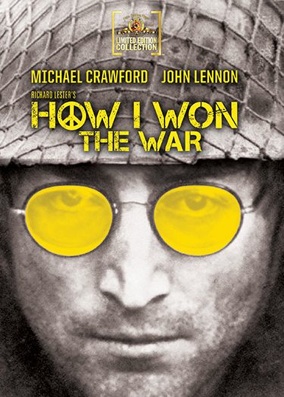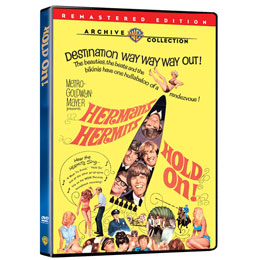DVD is dead. No, not as a delivery system for Hollywood hits like Thor and Fast Five, but as a way to catch up with older titles it’s pretty much extinct at the studio level. To their credit the studios are re-releasing the gems (and profit centers) of their catalogs as Blu-rays, with improved image and audio–and the same extras, or lack thereof, ported right over (often in standard definition, and sometimes, lazily, with the original DVDs thrown in so no one has to bother with replication).
 So where’s the new new? In MODs–those manufactured-on-demand DVD-Rs that I wrote about with great fanfare more than two years ago, before the scales fell from my eyes regarding Blu-ray and when I had just one mouth to feed. One never knows about these things but it looks like MODs are here to stay, before the rapture hits home video and migrates the chosen titles to Internet streaming. The Warner Archive, which got the ball rolling, continues to be out in front regarding number and image quality of titles, plus hard-to-come-by discounts; Sony’s Screen Classics by Request line offers consistently mouth-watering transfers of once-forgotten Columbia movies; the MGM Limited Edition Collection is full steam ahead after rough seas in the beginning (I purchased The Best Man three times until they got it right); and Universal has revived its seemingly abandoned Vault Series from its coma. Problems arise–the latest I’ve read about is buyers ordering a disc and finding a different film encoded on it, which can bring on heart attacks if you’ve sat down with The Nun and the Sergeant and found yourself with Burn Witch Burn instead–though they’ve gone from chronic from some distributors to manageable, and the skeptics have fallen silent. (The Home Theater Forum is the best place to check for flareups.)
So where’s the new new? In MODs–those manufactured-on-demand DVD-Rs that I wrote about with great fanfare more than two years ago, before the scales fell from my eyes regarding Blu-ray and when I had just one mouth to feed. One never knows about these things but it looks like MODs are here to stay, before the rapture hits home video and migrates the chosen titles to Internet streaming. The Warner Archive, which got the ball rolling, continues to be out in front regarding number and image quality of titles, plus hard-to-come-by discounts; Sony’s Screen Classics by Request line offers consistently mouth-watering transfers of once-forgotten Columbia movies; the MGM Limited Edition Collection is full steam ahead after rough seas in the beginning (I purchased The Best Man three times until they got it right); and Universal has revived its seemingly abandoned Vault Series from its coma. Problems arise–the latest I’ve read about is buyers ordering a disc and finding a different film encoded on it, which can bring on heart attacks if you’ve sat down with The Nun and the Sergeant and found yourself with Burn Witch Burn instead–though they’ve gone from chronic from some distributors to manageable, and the skeptics have fallen silent. (The Home Theater Forum is the best place to check for flareups.)
“Going MOD” is the best way to keep tabs on obscurities, failures, quirky curios, and yes, even good movies that have somehow fallen through the cracks. (And not just on DVD; some of these movies never made it to VHS or laserdisc, either.) The Sony initiative has brought me a bloody good Sherlock Holmes movie, 1965’s A Study in Terror (an early feature credit for Judi Dench), Michael Caine, Peter Cook, Dudley Moore, and Peter Sellers in the occasionally uproarious period comedy The Wrong Box (1966), and an unsung gem of suspense from 1944, Address Unknown, that was unknown to me. The Vault Series unearthed a fine-quality letterboxed print of Robert Aldrich’s great 1972 Western Ulzana’s Raid, replacing a flat and lifeless transfer that had gone out of print. I’ve lost track of the number of intriguing pictures that have come my way through the Warner Archive, from the beloved Japan-made sci-fi schlocker The Green Slime (1969) to Ken Russell’s toe-tapping 1971 film of the musical The Boy Friend to James Woods in the sleazily delightful prison movie Fast-Walking (1982); I see that the thrilling mercenary yarn Dark of the Sun (1968), from which Quentin Tarantino extracted a main theme (by Jacques Loussier) and a co-star (Rod Taylor) for his Inglourious Basterds, is up for pre-order. Sold!
A batch of arrivals from the MGM Limited Edition Collection typifies what MOD programs are all about. I picked up a cable favorite, 1980’s coming of age story Those Lips, Those Eyes (1980), with Frank Langella in a wonderful performance as a stock company player who contributes to the growing pains of stagestruck Cleveland teen Tom Hulce. Anticipating Alien, Queen of Blood (1966) inserts John Saxon and a pre-Easy Rider Dennis Hopper into a clever vampirism scenario comprised mostly of effects footage lifted from a Soviet sci-fi epic that the enterprising producer Roger Corman had purchased and made over. Cohen and Tate (1989) is a quick and dirty hit man thriller pairing a talkative Adam Baldwin with a close-mouthed Roy Scheider, on the last legs of his stardom. I was especially pleased to revisit Paul Schrader’s Patty Hearst (1988), a claustrophobic yet riveting account of the abduction and repurposing of the heiress, anchored by Natasha Richardson’s adventurous, ambiguous performance. (But you can’t win ’em all. 1974’s The Destructors is a promising title for a wan movie, with Caine, Anthony Quinn, and James Mason going through the motions in a more standard-issue hired killer scenario, set in the French Riviera.)
 Looking for something a little more “Popdose” I took a look at the MGM release of How I Won the War (1967). Here is a movie that you’d think would have made it onto standard DVD, given that its star (John Lennon) and director (Richard Lester) were hot off the two Beatles movies. I can imagine someone in the front office saying, “Yeah, we’ll get to it, we’ll get to it,” then as the market dwindled offloading it to the MOD division, unsure of what to make of it. I get it: British antiwar fare of the late 60s, like Tony Richardson’s The Charge of the Light Brigade (1968) and Richard Attenborough’s Oh! What a Lovely War (1969), still radiates boxoffice poison, and Lester’s film, with its thick accents and goonish humor, is USer-unfriendly. Still, someone cared enough to have Lester and editor John Victor-Smith supervise the transfer, and I’m told that, rare for mostly feature-free MODs, the package contains a commemorative album of behind-the-scenes photos (I didn’t get them).
Looking for something a little more “Popdose” I took a look at the MGM release of How I Won the War (1967). Here is a movie that you’d think would have made it onto standard DVD, given that its star (John Lennon) and director (Richard Lester) were hot off the two Beatles movies. I can imagine someone in the front office saying, “Yeah, we’ll get to it, we’ll get to it,” then as the market dwindled offloading it to the MOD division, unsure of what to make of it. I get it: British antiwar fare of the late 60s, like Tony Richardson’s The Charge of the Light Brigade (1968) and Richard Attenborough’s Oh! What a Lovely War (1969), still radiates boxoffice poison, and Lester’s film, with its thick accents and goonish humor, is USer-unfriendly. Still, someone cared enough to have Lester and editor John Victor-Smith supervise the transfer, and I’m told that, rare for mostly feature-free MODs, the package contains a commemorative album of behind-the-scenes photos (I didn’t get them).
Lennon’s face fronts the cover but he’s more of an ensemble player here, and a minor one at that, with Michael Crawford cast as a foppish, disapproving officer assigned to set up a cricket pitch in North Africa during World War II. That’s the gist of it, anyway, as he and his men are drawn into the absurdity of war, in a mess of styles that are passably interesting if you can get on Lester’s peculiar wavelength, where war parody bleeds into actual combat footage and dead characters return painted from head-to-toe as silent toy soldiers. Me, I tire pretty quickly from “funny” names (Lennon’s is Gripweed) and an intentionally scrambled and disconnected tone, from which, to be fair, I extracted a few gems. (When Gripweed reveals an early flirtation with fascism, a colonel, played the peerless Michael Hordern, insists that “fascism is something you grow out of.”) I assume Lennon, in this one stab at acting, got more from it, as he wrote “Strawberry Fields Forever” while on location in the Spain made famous by spaghetti Westerns and started wearing his round glasses. (And you’ll get those nice photos, sniff.)
For their film debut the Beatles got Lester; the Dave Clark Five got John Boorman (1965’s Having a Wild Weekend) and the Monkees, Bob Rafelson (1968’s Head). I figured Herman’s Hermits got the short end of the auteur stick when Arthur Lubin was assigned to their first starring feature, 1966’s Hold On!, but, in a remarkable instance of Popdose synchronicity, I figured wrong. Turns out Lubin, who had successfully directed Francis the talking mule and Mr. Ed the talking horse, was just the right guy for the Hermits, and the movie is a pleasant bit of cotton candy distinguished by 10 of their catchy songs. (You don’t get this one for the plot, which involves starlet Shelley Fabares and some skulduggery involving a Gemini space capsule named after the band.) Producer Sam Katzman produced a bunch of rock ‘n’ roll quickies for MGM in the 60s, including Roy Orbison’s lone feature The Fastest Guitar Alive (1967), and the Warner Archive has dug them up in relatively mint condition (Hold On! is presented in the proper Panavision 2.35:1 aspect ratio, so you can see all the Hermits in every shot). “The only similarity to Help! is the exclamation point” sniffed the Boston Globe–but here and in 1968’s Mrs. Brown, You’ve Got a Lovely Daughter, also available from the Warner Archive, they certainly put some mod into MOD.




Comments